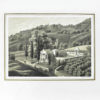Lot 62. RUPPELL, Eduard.
Erklärende Notizen zu einer Reihenfolge bildlicher Darstellungen der Villa Mylius zu Loveno am Comer See und der benachbarten Gegend.
Unsold
Erklärende Notizen zu einer Reihenfolge bildlicher Darstellungen der Villa Mylius zu Loveno am Comer See und der benachbarten Gegend. 86519
Von einem vieljährigen Freunde der Familie Mylius entworfen.
Milan, Joseph Bernardoni, 1852
Extremely rare publication on one of the most important centres of German-Italian cultural exchange in the 19th Century.
This set of views shows the magnificent country estate of the Mylius family near the village Loveno on Lake Como, which was bought by banker and art patron Heinrich Mylius (1769-1854) as a gift for his son Julius in 1829. The following year Julius died at the age of 30, shortly after his marriage with the Milanese aristocrat’s daughter Luigia Vitali, and the estate was converted into a memorial. It is now open to the public as the museum Villa Vigoni.
Born in Frankfurt, Heinrich Mylius is remembered in Germany and Northern Italy as one of Milan’s most prominent industrialists in the nineteenth century as well as a great promoter of cultural exchange between Germany and Italy at the time. Mylius developed strong ties with important European literary and artistic figures of his time. He was a close friend of Johann Wolfgang Goethe, the artist Bertel Thorvaldsen, the writer Alessandro Manzoni and the philosopher Carlo Cattaneo to mention just a few. After his son’s death, Villa Mylius (later Vigoni) became the centre of the family’s philanthropic activities and the fulcre of cultural exchanges between Italy and the Mitteleuropean region.
Testament to this notion of cultural dialogue between northern and southern Europe, many of the works in the Villa, that are reproduced in the plates of this volume, were commissioned from artists who were either friends or acquaintances of the family. Notably, the bas-reliefs from the funerary chapel of Julius Mylius appear in the first five plates. In plates 1,3 and 5, we see engraved reproductions of works by the Italian sculptor Pompeo Marchesi “”La morte di Giulio Mylius“” and Thorvaldsen’s “”Nemesis“” in plates 2 and 4.
Other engravings in the volume pay homage not only to the landscape of the Villa, but also to the art exhibited within it.
Mylius emerges as an attentive patron of Italian art from the Risorgimento masters, and in particular the celebrated Francesco Hayez, whose masterpiece “”Luigia Vitali vedova Mylius“” still hangs in Villa Vigoni and whose portraits of Julius Mylius and his mother, Friederike Schnauss, are here reproduced in plates 11 and 12. The other sculptural groups illustrated in this work, all following a Biblical theme, also come from German and Italian ateliers.
Mylius, so attentive to new trends in the arts, promoted the synthesis between traditional skills and innovation in his business enterprises as well. The family owned several silk manufactories in northern Italy where he introduced innovative methods of production, such as spinning cocoons in the cold, a new technique which allowed workers to save time and consume less energy. His interest in craft and labour was not merely an entrepreneurial endeavour but also an intellectual and philanthropic pursuit. In this spirit, he founded the “”Society for the encouragement of arts and crafts”” (Societa’ per l’incoraggiamento delle arti e mestieri), at the time a philanthropic organisation and a vocational school, now remembered as the first stage in the formation of the “”Politecnico di Milano””, one of the best schools architecture and engineering in the world.
The text accompanying the plates was compiled by the illustrious naturalist, explorer, numismatist and close friend of the Mylius family Eduard Rüppell (1794-1884), known in particular for his travels around Egypt, Nubia and Abyssinia.
Today the work offers an insight not only into the world of the Mylius family, but also into the feverish intellectual and artistic landscape of Germany and Italy in the years that preceded the unification of Italy in 1861.
Description
Two volumes, atlas folio (48 x 34,5 cm) and text 4to (29 x 20 cm) in 1. Atlas: lithographed title, 16 plates, including one folding; text 13, 5 pp.; light occasional spotting to plates. Original cloth and wrappers, upper wrapper watermarked “”Fco VeSe”” and double headed eagle coat of arms, lower wrapper watermarked with crescent moon; a bit faded, light spotting, very small worming to spine.








